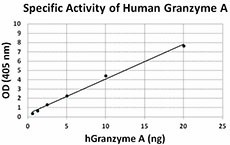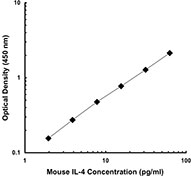- Regulatory Status
- RUO
- Other Names
- Hanukah factor serine protease (HFSP), Cytolytic T cell-and natural killer cell-specific trypsin-like serine protease, Cytotoxic T-lymphocyte-associated serine esterase 3 (CTLA3)
- Ave. Rating
- Submit a Review
- Product Citations
- publications

-

The activity of recombinant human granzyme A is determined by its ability to cleave a colorimetric peptide substrate, N-carbobenzyloxy-Gly-Arg-ThioBenzyl ester (Z-GR-SBzl), in the presence of 5,5'Dithio-bis (2-nitrobenzoic acid) (DTNB) with an activity of >5,000 pmol/min/µg.
| Cat # | Size | Price | Quantity Check Availability | Save | ||
|---|---|---|---|---|---|---|
| 550802 | 10 µg | 175€ | ||||
| 550804 | 25 µg | 348€ | ||||
Select size of product is eligible for a 40% discount! Promotion valid until December 31, 2024. Exclusions apply. To view full promotion terms and conditions or to contact your local BioLegend representative to receive a quote, visit our webpage.
Granzyme A is a serine protease belonging to the granzyme family and is expressed exclusively by cytotoxic T cells (CTL) and NK cells. Most circulating CD56+CD8- NK cells, and approximately half of circulating CD8+ T cells, coexpress both granzymes A and B. In contrast, few circulating CD4+ T cells express granzyme A or B. Activation of CD8+ and CD4+ T lymphocytes induces substantial expression of granzyme B, but not granzyme A. Following receptor-mediated conjugate formation between a granzyme-containing cell and an infected or transformed target cell, granzymes enter the target cell via endocytosis and induce apoptosis. Granzyme A was found to induce caspase independent cell death when it enters into the target cell by perforin. Once in a cell, granzyme A activates DNA nicking by DNAse NM23-H1, a tumor suppressor gene product whose expression is reduced in transformed, metastatic cells. Dysregulation of this pathway results in several human diseases, such as hemophagocytic lymphohistiocytosis. Besides the protease activity, granzyme A induces human lung fibroblasts to produce IL-6 and IL-8. Cytokine induction is abrogated by treating the serine protease with the suicide serine protease inhibitor 3,4-dichloroisocoumarin. Other fibroblast lines, as well as epithelial cells, produce cytokines in response to granzyme A. These findings suggest that granzyme A can function as an activation molecule with potentially important immunoregulatory functions. However, CTLs from mice lacking granzyme A induce morphologically normal apoptosis in vitro, but those from mice that are deficient of granzyme B induce the nuclear features of apoptosis (particularly DNA fragmentation) more slowly than do wild-type CTLs.
Product DetailsProduct Details
- Source
- Human Granzyme A, amino acids (Cys26-Val262) (Accession# NP_006135.1), is expressed with a C-terminal 10 His tag and a linker sequence in the 293E cell line.
- Molecular Mass
- This 252 amino acid recombinant protein has a predicted molecular mass of approximately 28 kD. The protein migrates at about 35 kD in DTT-reducing conditions and about 55 kD in non-reducing conditions by SDS-PAGE.The predicted N-terminal amino acid is Cys.
- Purity
- >90%, as determined by Coomassie stained SDS-PAGE.
- Formulation
- 0.22 µm filtered protein solution is in 20 mM Tris, 150 mM NaCl, pH 8.0
- Endotoxin Level
- Less than 1.0 EU per µg of protein as determine by the LAL method.
- Concentration
- 10 and 25 µg sizes are bottled at 200 µg/mL.
- Storage & Handling
- Unopened vial can be stored at -70°C for six months. For maximum results, quick spin vial prior to opening. Avoid repeated freeze/thaw cycles.
- Activity
- Lysyl endopeptidase activated human granzyme A cleaves the peptide substrate N-carbobenzyloxy-Gly-Arg-ThioBenzyl ester (Z-GR-SBzl), in the presence of 5,5'Dithio-bis (2-nitrobenzoic acid) (DTNB), with an activity >5,000 pmol/min/µg.
- Application
-
Bioassay
- Application Notes
-
This protein is in the latent form and needs to be activated for bioassay.
BioLegend carrier-free recombinant proteins provided in liquid format are shipped on blue-ice. Our comparison testing data indicates that when handled and stored as recommended, the liquid format has equal or better stability and shelf-life compared to commercially available lyophilized proteins after reconstitution. Our liquid proteins are verified in-house to maintain activity after shipping on blue ice and are backed by our 100% satisfaction guarantee. If you have any concerns, contact us at tech@biolegend.com.
Antigen Details
- Structure
- Monomer
- Distribution
-
CTL and NK cells.
- Function
- Granzyme A is able to induce target cell apoptosis by activating caspase independent pathways.
- Interaction
- Targets of CTL and NK cells.
- Bioactivity
- Lysyl endopeptidase activated human granzyme A is able to cleave a colorimetric peptide substrate, N-carbobenzyloxy-Gly-Arg-ThioBenzyl ester (Z-GR-SBzl), in the presence of 5,5'Dithio-bis (2-nitrobenzoic acid) (DTNB).
- Biology Area
- Cell Biology, Immunology, Innate Immunity, Neuroscience
- Molecular Family
- Enzymes and Regulators, Proteases
- Antigen References
-
1. Edwards KM, et al. 1999. J. Biol. Chem. 274:30468.
2. Lieberman J, and Fan Z. 2003. Curr. Opin. Immunol. 15:553.
3. Fan Z, et al. 2003. Cell. 112:659.
4. Sower LE, et al. 1996. Cell Immunol. 171:159.
5. Grossman WJ. et al. 2004. Blood. 104:2840.
6. Ebnet K, et al. 1995. EMBO J. 14:4230.
7. Heusel JW, et al. 1994. Cell. 76:977. - Gene ID
- 3001 View all products for this Gene ID
- UniProt
- View information about Granzyme A on UniProt.org
Related FAQs
- Why choose BioLegend recombinant proteins?
-
• Each lot of product is quality-tested for bioactivity as indicated on the data sheet.
• Greater than 95% Purity or higher, tested on every lot of product.
• 100% Satisfaction Guarantee for quality performance, stability, and consistency.
• Ready-to-use liquid format saves time and reduces challenges associated with reconstitution.
• Bulk and customization available. Contact us.
• Learn more about our Recombinant Proteins. - How does the activity of your recombinant proteins compare to competitors?
-
We quality control each and every lot of recombinant protein. Not only do we check its bioactivity, but we also compare it against other commercially available recombinant proteins. We make sure each recombinant protein’s activity is at least as good as or better than the competition’s. In order to provide you with the best possible product, we ensure that our testing process is rigorous and thorough. If you’re curious and eager to make the switch to BioLegend recombinants, contact your sales representative today!
- What is the specific activity or ED50 of my recombinant protein?
-
The specific activity range of the protein is indicated on the product datasheets. Because the exact activity values on a per unit basis can largely fluctuate depending on a number of factors, including the nature of the assay, cell density, age of cells/passage number, culture media used, and end user technique, the specific activity is best defined as a range and we guarantee the specific activity of all our lots will be within the range indicated on the datasheet. Please note this only applies to recombinants labeled for use in bioassays. ELISA standard recombinant proteins are not recommended for bioassay usage as they are not tested for these applications.
- Have your recombinants been tested for stability?
-
Our testing shows that the recombinant proteins are able to withstand room temperature for a week without losing activity. In addition the recombinant proteins were also found to withstand four cycles of freeze and thaw without losing activity.
- Does specific activity of a recombinant protein vary between lots?
-
Specific activity will vary for each lot and for the type of experiment that is done to validate it, but all passed lots will have activity within the established ED50 range for the product and we guarantee that our products will have lot-to-lot consistency. Please conduct an experiment-specific validation to find the optimal ED50 for your system.
- How do you convert activity as an ED50 in ng/ml to a specific activity in Units/mg?
-
Use formula Specific activity (Units/mg) = 10^6/ ED50 (ng/mL)
 Login / Register
Login / Register 














Follow Us